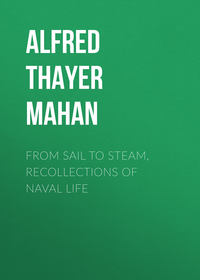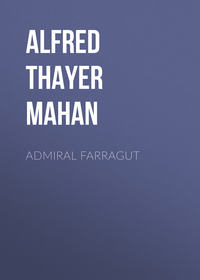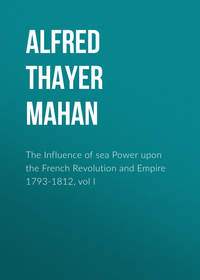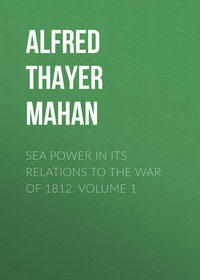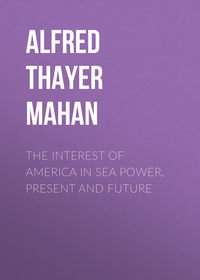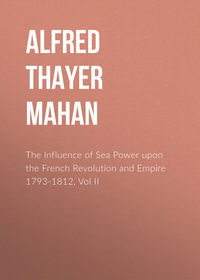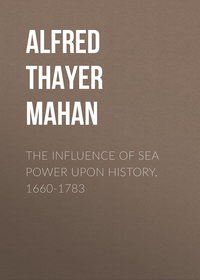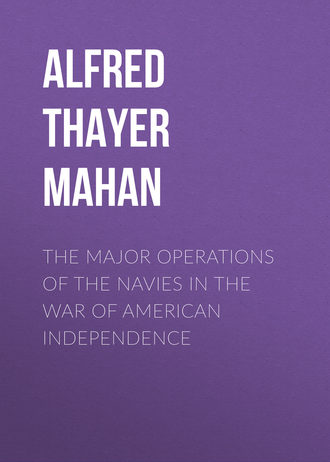 полная версия
полная версияThe Major Operations of the Navies in the War of American Independence
On April 11th the British squadron reached Porto Praya, Cape de Verde Islands. This bay is open to the southward, extending from east to west about a mile and a half, and is within the limits of the north-east trade-winds. Although aware that a French division was on his track, and conscious, by the admissions of his report, that protection could not be expected from the neutrality of the place, Johnstone permitted his vessels to anchor without reference to attack. His own flagship, the Romney, 50, was so surrounded by others that she could fire only with great caution through intervals. On the 16th of April, at 9.30 A.M., the Isis, 50, which was the outermost of the British squadron, signalled eleven sail in the north-east. Fifteen hundred persons were then ashore engaged in watering, fishing, embarking cattle, and amusing themselves. The strangers were Suffren's division. The meeting was not expected by the French commander, whose object in entering was simply to complete the water of the ships; but he determined at once to attack, and hauled round the east point of the bay in column, the two seventy-fours at the head, his own ship, the Héros, leading with the signal for battle (line ab). Passing through, or along, the disordered enemy until he reached the only seventy-four among them, he there luffed to the wind, anchoring five hundred feet from the starboard beam of this vessel (f) which by an odd coincidence bore the same name—Hero. From this position he at once opened fire from both broadsides. His next astern, the Annibal (b), brought up immediately ahead of him, but so close that the Héros had to veer cable and drop astern (a), which brought her on the beam of the Monmouth, 64139 (m). The captain of the Annibal had thought the order for battle merely precautionary, and had not cleared for action. He was therefore taken unawares, and his ship did no service proportionate to her force. The third French vessel (c) reached her station, but her captain was struck dead just when about to anchor, and in the confusion the anchor was not let go. The ship drifted foul of a British East Indiaman, which she carried out to sea (c' c"). The two remaining French (d, e) simply cannonaded as they passed across the bay's mouth, failing through mishap or awkwardness to reach an effective position.
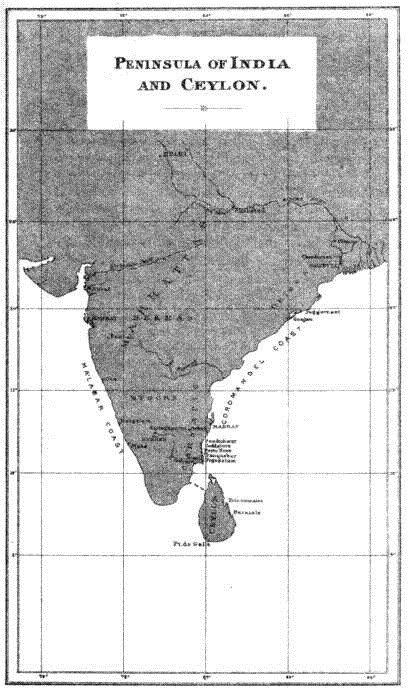
xJohnstone and Suffren, Porto Praya, April 16, 1781
The attack thus became a mere rough and tumble, in which the two seventy-fours alone sustained the French side. After three quarters of an hour, Suffren, seeing that the attempt had failed, slipped his cable and put to sea. The Annibal followed, but she had been so damaged that all her masts went overboard; fortunately, not until her head was pointed out of the harbour. Johnstone, thus luckily escaping the consequences of his neglect, now called his captains together to learn the condition of their ships, and then ordered them to cut their cables and pursue. All obeyed except Captain Sutton of the Isis, who represented that the spars and rigging of his ship could not bear sail at once. Johnstone then ordered him to come out anyhow, which he did, and his fore topmast shortly went overboard. The disability of this ship so weighed upon the Commodore that his pursuit was exceedingly sluggish; and the French kept drawing him away to leeward, the Annibal having got a bit of canvas on a jury foremast. Night, therefore, was falling as Johnstone came near them; the Isis and Monmouth were two or three miles astern; the sea was increasing; if he got much further to leeward, he could not get back; he had forgotten to appoint a rendezvous where the convoy might rejoin; a night action, he considered, was not to be thought of. Yet, if he let the enemy go, they might anticipate him at the Cape. In short, Johnstone underwent the "anguish" of an undecided man in a "cruel situation,"140 and of course decided to run no risks. He returned therefore to Porto Praya, put the captain of the Isis under arrest, and remained in port for a fortnight. Suffren hurried on to the Cape, got there first, landed his troops, and secured the colony against attack. Johnstone arrived in the neighbourhood some time later, and, finding himself anticipated, turned aside to Saldanha Bay, where he captured five Dutch East Indiamen. He then sent the Hero, Monmouth, and Isis on to India, to reinforce Hughes, and himself went back to England.
No accusation of misbehavior lies against any of the British subordinates in this affair of Porto Praya. The captain of the Isis was brought to a court-martial, and honourably acquitted of all the charges. The discredit of the surprise was not redeemed by any exhibition of intelligence, energy, or professional capacity, on the part of the officer in charge. It has been said that he never had commanded a post-ship141 before he was intrusted with this very important mission, and it is reasonably sure that his selection for it was due to attacks made by him upon the professional conduct of Keppel and Howe, when those admirals were at variance with the administration.142 His preposterous mismanagement, therefore, was probably not wholly bitter to the Navy at large. In the British ships of war, the entire loss in men, as reported, was only 9 killed, 47 wounded. Several casualties from chance shots occurred on board the convoy, bringing up the total to 36 killed and 130 wounded. The French admit 105 killed and 204 wounded, all but 19 being in the Héros and Annibal. Although precipitated by Suffren, the affair clearly was as great a surprise to his squadron as to the British. Therefore, the latter, being already at anchor and more numerous as engaged, had a distinct advantage; to which also contributed musketry fire from the transports. Nevertheless, the result cannot be deemed creditable to the French captains or gunnery.
Suffren remained in the neighbourhood of the Cape for two months. Then, having seen the colony secure, independent of his squadron, he departed for the Ile de France, arriving there October 25th. On the 17th of December the whole French force, under the command of d'Orves, sailed for the Coromandel coast. On the way the British 50-gun ship Hannibal, Captain Alexander Christie, was taken. On the 9th of February, 1782, Comte d'Orves died, and Suffren found himself at the head of twelve ships of the line: three 74's, seven 64's and two 50's.143 On the 15th Hughes's fleet was sighted, under the guns of Madras. It numbered nine of the line: two 74's, one 68, five 64's, and one 50. Suffren stood south towards Pondicherry, which had passed into the power of Hyder Ali. After nightfall Hughes got under way, and also steered south. He feared for Trincomalee, in Ceylon, recently a Dutch port, which the British had captured on the 5th of January. It was a valuable naval position, as yet most imperfectly defended.
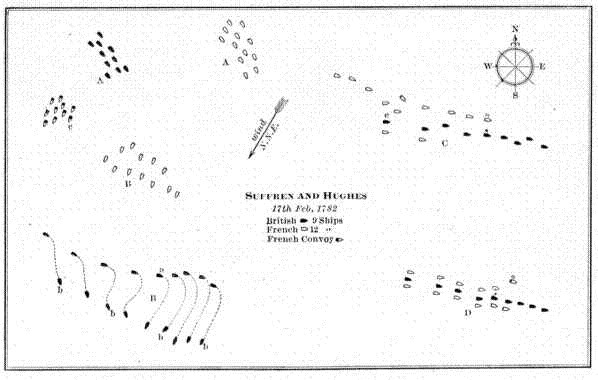
Hughes and Suffren, February 17, 1782
At daylight the British saw the French squadron twelve miles east (A, A) and its transports nine miles south-west (c). Hughes chased the latter and took six. Suffren pursued, but could not overtake before sunset, and both fleets steered south-east during the night. Next morning there were light north-north-east airs, and the French were six miles north-east of the British (B, B). The latter formed line on the port tack (a), heading to seaward; Hughes hoping that thus the usual sea-breeze would find him to windward. The breeze, however, did not make as expected; and, as the north-east puffs were bringing the enemy down, he kept off before the wind (b) to gain time for his ships to close their intervals, which were too great. At 4 P.M. the near approach of the French compelled him to form line again, (C), on the port tack, heading easterly. The rear ship, Exeter, 64 (e), was left separated, out of due support from those ahead. Suffren, leading one section of his fleet in person, passed to windward of the British line, from the rear, as far as Hughes's flagship, which was fifth from the van. There he stopped, and kept at half cannon-shot, to prevent the four ships in the British van from tacking to relieve their consorts. It was his intention that the second half of his fleet should attack the other side of the English rear. This plan of intended battle is shown by the figure D in the diagram. Actually, only two of the French rear did what Suffren expected, engaging to leeward of the extreme British rear; the others of the French rear remaining long out of action (C). The figure C shows the imperfect achievement of the design D. However, as the position of Suffren's flagship prevented the British van from tacking into action, the net result was, to use Hughes's own words, that "the enemy brought eight of their best ships to the attack of five of ours." It will be noted with interest that these were exactly the numbers engaged in the first act of the battle of the Nile. The Exeter (like the Guerrier at the Nile) received the fresh broadsides of the first five of the enemy, and then remained in close action on both sides, assailed by two, and at last by three, opponents,—two 50's, and one 64. When the third approached, the master of the ship asked Commodore Richard King, whose broad pennant flew at her masthead, "What is to be done?" "There is nothing to be done," replied King, "but to fight her till she sinks." Her loss, 10 killed and 45 wounded, was not creditable under the circumstances to the French gunnery, which had been poor also at Porto Praya. At 6 P.M. the wind shifted to south-east, throwing all on the other tack, and enabling the British van at last to come into action. Darkness now approaching, Suffren hauled off and anchored at Pondicherry. Hughes went on to Trincomalee to refit. The British loss had been 32 killed, among whom were Captain William Stevens of the flagship, and Captain Henry Reynolds, of the Exeter, and 83 wounded. The French had 30 killed; the number of their wounded is put by Professor Laughton at 100.
On the 12th of March Hughes returned to Madras, and towards the end of the month sailed again for Trincomalee carrying reinforcements and supplies. On the 30th he was joined at sea by the Sultan, 74, and the Magnanime, 64, just from England. Suffren had remained on the coast from reasons of policy, to encourage Hyder Ali in his leaning to the French; but, after landing a contingent of troops on the 22d of March, to assist at the siege of the British port of Cuddalore, he put to sea on the 23d, and went south, hoping to intercept the Sultan and Magnanime off the south end of Ceylon. On the 9th of April he sighted the British fleet to the south and west of him. Hughes, attaching the first importance to the strengthening of Trincomalee, had resolved neither to seek nor to shun action. He therefore continued his course, light northerly airs prevailing, until the 11th, when, being about fifty miles to the north-east of his port, he bore away for it. Next morning, April 12th, finding that the enemy could overtake his rear ships, he formed line on the starboard tack, at two cables' intervals, heading to the westward, towards the coast of Ceylon, wind north by east, and the French dead to windward (A, A). Suffren drew up his line (a) on the same tack, parallel to the British, and at 11 A.M. gave the signal to steer west-south-west all together; his vessels going down in a slanting direction (bb'), each to steer for one of the enemy. Having twelve ships to eleven, the twelfth was ordered to place herself on the off side of the rear British, which would thus have two antagonists.
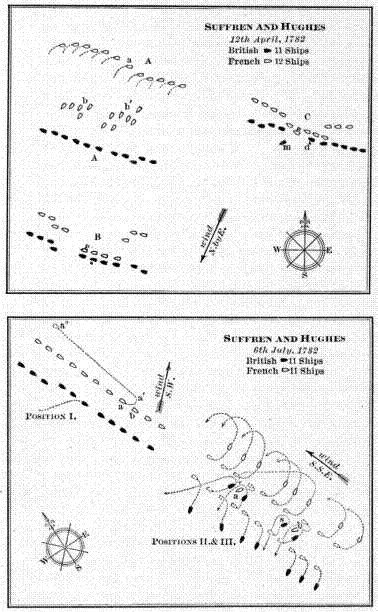
Hughes and Suffren, April 12, 1782
Hughes and Suffren, July 6, 1782
In such simultaneous approach it commonly occurred that the attacking line ceased to be parallel with the foe's, its van becoming nearer and rear more distant. So it was here. Further, the British opening fire as soon as the leading French were within range, the latter at once hauled up to reply. Suffren, in the centre, wishing closest action, signalled them to keep away again, and himself bore down wrathfully upon Hughes to within pistol-shot; in which he was supported closely by his next ahead and the two next astern. The rear of the French, though engaged, remained too far distant. Their line, therefore, resembled a curve, the middle of which—four or five ships—was tangent to the British centre (B). At this point the heat of the attack fell upon Hughes's flagship, the Superb, 74 (C, d), and her next ahead, the Monmouth, 64. Suffren's ship, the Héros, having much of her rigging cut, could not shorten sail, shot by the Superb, and brought up abreast the Monmouth. The latter, already hotly engaged by one of her own class, and losing her main and mizzen masts in this unequal new contest, was forced at 3 P.M. to bear up out of the line (m). The place of the Héros alongside the Superb was taken by the Orient, 74, supported by the Brillant, 64; and when the Monmouth kept off, the attack of these two ships was reinforced by the half-dozen stern chasers of the Héros, which had drifted into the British line, and now fired into the Superb's bows. The conflict between these five ships, two British and three French, was one of the bloodiest in naval annals; the loss of the Superb, 59 killed and 96 wounded, and of the Monmouth, 45 killed and 102 wounded, equalling that of the much larger vessels which bore the flags of Nelson and Collingwood at Trafalgar. The loss of the three French was 52 killed and 142 wounded; but to this should be added properly that of the Sphinx, 64, the Monmouth's first adversary: 22 killed and 74 wounded. At 3.40 P.M., fearing that if he continued steering west he would get entangled with the shore, Hughes wore his ships, forming line on the port tack, heading off shore. The French also wore, and Suffren hoped to secure the Monmouth, which was left between the two lines; but the quickness of a British captain, Hawker, of the Hero, ran a tow-rope to her in time, and she was thus dragged out of danger. At 5.40 Hughes anchored, and Suffren did the same at 8 P.M. The total British loss in men on this occasion was 137 killed and 430 wounded; that of the French 137 killed, and 357 wounded.
The exhausted enemies remained at anchor in the open sea, two miles apart, for a week, repairing. On the 19th of April the French got under way and made a demonstration before the British, inviting battle, yet not attacking; but the condition of the Monmouth forbade Hughes from moving. Suffren therefore departed to Batacalo, in Ceylon, south of Trincomalee, where he covered his own convoys from Europe, and flanked the approach of his adversary's. Hughes, on the 22d of April, got into Trincomalee, where he remained till June 23d. He then went to Negapatam, formerly a Dutch possession, but then held by the British. There he learned that Suffren, who meanwhile had captured several British transports, was a few miles north of him, at Cuddalore, which had surrendered to Hyder Ali on April 4th. On the 5th of July, at 1 P.M., the French squadron appeared. At 3 P.M. Hughes put to sea, and stood south during the night to gain the wind,—the south-west monsoon now blowing.
Next morning, at daylight, the French were seen at anchor, seven or eight miles to leeward. At 6 A.M. they began to get under way. One of their sixty-fours, the Ajax, had lost her main and mizzen topmasts in a violent squall on the previous afternoon, and was not in the line. There were therefore eleven ships on each side. The action, known as that of Negapatam, began shortly before 11, when both fleets were on the starboard tack, heading south-south-east, wind south-west. The British being to windward, Hughes ordered his fleet to bear up together to the attack, exactly as Suffren had done on the 12th of April. As commonly happened, the rear got less close than the van (Position I). The fourth ship in the French order, the Brillant, 64 (a), losing her mainmast early, dropped to leeward of the line, (a'), and astern of her place (a"). At half-past noon the wind flew suddenly to south-south-east,—the sea-breeze,—taking the ships a little on the port bow. Most of them, on both sides, paid off from the enemy, the British to starboard, the French to port; but between the main lines, which were in the momentary confusion consequent upon such an incident, were left six ships—four British and two French—that had turned the other way (Positions II and III).144 These were the Burford, Sultan (s), Worcester, and Eagle, fourth, fifth, eighth and tenth, in the British order; and the Sévère (b), third in the French, with the dismasted Brillant, which was now towards the rear of the fight (a). Under these conditions, the Sévère, 64, underwent a short but close action with the Sultan, 74; and with two other British ships, according to the report of the Sévère's captain. The remainder of the incident shall be given in the latter's own words.
"Seeing the French squadron drawing off,—for all the ships except the Brillant had fallen off on the other tack,—Captain de Cillart thought it useless to prolong his defence, and had the flag hauled down. The ships engaged with him immediately ceased their fire, and the one on the starboard side moved away. At this moment the Sévère fell off to starboard, and her sails filled. Captain de Cillart then ordered the fire to be resumed by his lower-deck guns, the only ones which remained manned, and he rejoined his squadron."
When the Sévère's flag came down, Suffren was approaching with his flagship. The Sultan wore to rejoin her fleet, and was raked by the Sévère in so doing. The Brillant, whose mainmast had been shot away in conflict with either the Sultan or the Burford, both much heavier ships, had at this later phase of the fight fallen under the guns of the Worcester and the Eagle. Her captain, de Saint-Félix, was one of the most resolute of Suffren's officers. She was rescued by the flagship, but she had lost 47 killed and 136 wounded,—an almost incredible slaughter, being over a third of the usual complement of a sixty-four; and Suffren's ships were undermanned.
These spirited episodes, and the fact that his four separated ships were approaching the enemy, and being approached by them, caused Hughes to give the orders to wear, and for a general chase; the flag for the line being hauled down. These signals would bring all the main body to the support of the separated ships, without regard to their order in battle, and therefore with the utmost expedition that their remaining sail power would admit. Two of the fleet, however, made signals of disability; so Hughes annulled the orders, and at 1.30 formed on the port tack, recalling the engaged vessels. Both squadrons now stood in shore, and anchored at about 6 P.M.; the British near Negapatam, the French some ten miles north. The loss in the action had been: British, 77 killed, 233 wounded; French, 178 killed, 601 wounded.
On the following day Suffren sailed for Cuddalore. There he received word that two ships of the line—the Illustre, 74, and St. Michel, 60, with a convoy of supplies and 600 troops—were to be expected shortly at Pointe de Galle, then a Dutch port, on the south-west side of Ceylon. It was essential to cover these, and on the 18th he was ready for sea; but the necessity of an interview with Hyder Ali delayed him until the 1st of August, when he started for Batacalo. On the 9th he arrived there, and on the 21st the reinforcement joined him. Within forty-eight hours the supply-ships were cleared, and the squadron sailed again with the object of taking Trincomalee. On the 25th he was off the port, and, the operation being pushed energetically, the place capitulated on the 31st of August.
It is difficult to resist the impression that greater energy on Hughes's part might have brought him up in time to prevent this mishap. He reached Madras only on July 20th, a fortnight after the late action; and he did not sail thence until the 20th of August, notwithstanding that he apprehended an attempt upon Trincomalee. Hence, when he arrived there on the 2d of September, not only had it passed into the hands of the enemy, but Suffren had reëmbarked already the men and the guns that had been landed from his fleet. When Hughes's approach was signalled, all preparations for sea were hastened, and the following morning, at daybreak, the French came out. Hughes had been joined since the last action by the Sceptre, 64, so that the respective forces in the action fought off Trincomalee on September 3d were twelve of the line to fourteen, viz.: British, three 74's, one 70, one 68, six 64's, one 50; French, four 74's, seven 64's, one 60, two 50's. Suffren had also put into the line a 36-gun ship, the Consolante.145
While the French were getting underway from Trincomalee, the British fleet was standing south-south-east towards the entrance, close-hauled on the starboard tack, a fresh south-west monsoon blowing. When Hughes made out the hostile flags on the works, he kept away four points,146 and steered east-south-east, still in column, under short canvas (A). Suffren pursued, being to windward yet astern, with his fleet on a line of bearing; that is, the line on which the ships were ranged was not the same as the course which they were steering. This formation, (A), wherein the advance is oblique to the front, is very difficult to maintain. Wishing to make the action, whatever the immediate event, decisive in results, by drawing the French well to leeward of the port, Hughes, who was a thorough seaman and had good captains, played with his eager enemy. "He kept avoiding me without taking flight," wrote Suffren; "or rather, he fled in good order, regulating his canvas by his worst sailers; and, keeping off by degrees, he steered from first to last ten or twelve different courses." Hughes, on his part, while perfectly clear as to his own object, was somewhat perplexed by the seeming indecision of an adversary whose fighting purpose he knew by experience. "Sometimes they edged down," he wrote; "sometimes they brought-to; in no regular order, as if undetermined what to do." These apparent vacillations were due to the difficulty of maintaining the line of bearing, which was to be the line of battle; and this difficulty was the greater, because Hughes was continually altering his course and Suffren's ships were of unequal speed.
At length, at 2 P.M., being then twenty-five miles south-east of the port, the French drew near enough to bear down. That this movement might be carried out with precision, and all the vessels come into action together, Suffren caused his fleet to haul to the wind, on the starboard tack, to rectify the order. This also being done poorly and slowly, he lost patience,—as Nelson afterwards said, "A day is soon lost in manœuvring,"—and at 2.30, to spur on the laggard ships, the French admiral gave the signal to attack, (a), specifying pistol-range. Even this not sufficing to fetch the delinquents promptly into line with the flagship, the latter fired a gun to enforce obedience. Her own side being still turned towards the British, as she waited, the report was taken by the flagship's men below decks to be the signal for opening fire, and her whole broadside was discharged. This example was followed by the other ships, so that the engagement, instead of being close, was begun at half cannon-shot.
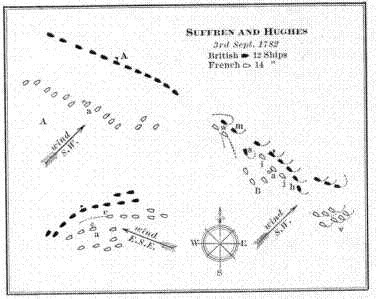
Hughes and Suffren, September 3, 1782
Owing to his measured and deliberate retreat, Hughes had his fleet now in thoroughly good shape, well aligned and closed-up. The French, starting from a poor formation to perform a difficult evolution, under fire, engaged in utter disorder (B). Seven ships, prematurely rounding-to to bring their broadsides to the enemy, and fore-reaching, formed a confused group (v), much to windward and somewhat ahead of the British van. Imperfectly deployed, they interfered with one another and their fire consequently could not be adequately developed. In the rear a somewhat similar condition existed. Suffren, expecting the bulk of his line to fight the British to windward, had directed the Vengeur, 64, and the Consolante, 36, to double to leeward on the extreme rear; but they, finding that the weather sides of the enemy were not occupied, feared to go to leeward, lest they should be cut off. They attacked the rear British ship, the Worcester, 64 (w), to windward; but the Monmouth, 64 (m), dropping down to her support, and the Vengeur catching fire in the mizzen top, they were compelled to haul off. Only Suffren's own ship, the Héros, 74 (a), and her next astern, the Illustre, 74, (i), came at once to close action with the British centre; but subsequently the Ajax, 64, succeeding in clearing herself from the snarl in the rear, took station ahead (j) of the Héros. Upon these three fell the brunt of the fight. They not only received the broadsides of the ships immediately opposed to them, but, the wind having now become light yet free, the British vessels ahead and astern, (h, s,) by luffing or keeping off, played also upon them. "The enemy formed a semicircle around us," wrote Suffren's chief of staff, "and raked us ahead and astern, as the ship came up and fell off with the helm to leeward." The two seventy-fours were crushed under this fire. Both lost their main and mizzen masts in the course of the day, and the foretopmast of the flagship also fell. The Ajax, arriving later, and probably drawing less attention, had only a topmast shot away.




